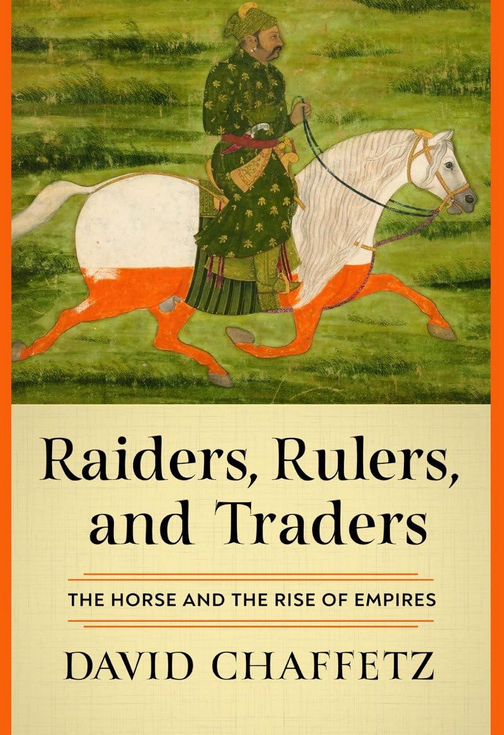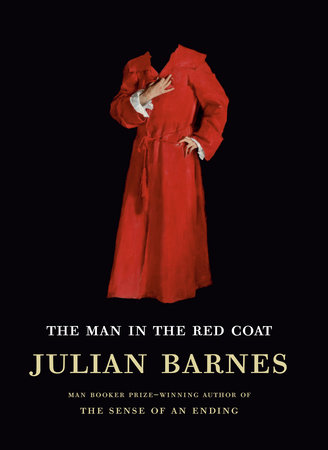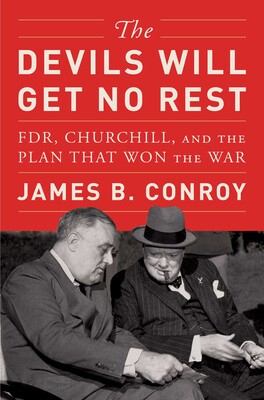Raiders, Rulers, and Traders: The Horse and the Rise of Empires
- By David Chaffetz
- W.W. Norton & Company
- 448 pp.
- Reviewed by Charles Caramello
- July 30, 2024
A sturdy assessment of the equine’s impact on civilization.

More than any other animal, canines and equines have enjoyed (or endured) a special relationship with humans and a central role in the human experience. Their respective relationships and roles differ, however, since dogs primarily have served us as household companions and protectors, and horses primarily as workplace partners and laborers. The dog has affected untold human lives, but the horse has shaped human history. For over five millennia, into the 20th century, the horse generated humans’ primary source of power for transportation, agriculture, industry, and war.
Not surprisingly, horses have inspired a vast bibliography. F.H. Huth’s Works on Horses and Equitation: A Bibliographical Record of Hippology (1887), for example, lists titles, often multiple volumes, by over 1,800 authors dating to 430 BCE. More recent and local, Anne Grimshaw’s The Horse: A Bibliography of British Books 1851-1976 (1982) contains more than 3,000 entries for that period alone. While books on horses have varied in approach and subject matter, those that take a long view on the animal in human history generally focus either on the horse in war or in art, or on horsemanship.
David Chaffetz’s Raiders, Rulers, and Traders: The Horse and the Rise of Empires (henceforth, RRT) also takes a long view, but one on the horse’s determinative and ubiquitous influence on the economics and politics of the Eurasian steppe and its adjacent settled civilizations. It opens with two sweeping chapters on the “entanglement” of humans and horses from 40000 BCE to 500 BCE. They form a prehistory, or prelude, to the main story that Chaffetz unspools in 10 chapters progressing from 500 BCE to the 20th century, each covering three or four centuries and discussing two or three steppe and settled empires.
Formidable in scale and scope, though intentionally narrow in focus, RRT argues that “the horse is the key to understanding the history of the vast territory stretching from the Danube to the Yellow River [and] should be at the center of our inquiries into ancient state formation, the relationships between settled and steppe civilizations, and the political dynamics of horse-breeding peoples.” The horse’s “role in shaping civilization” in general, Chaffetz contends, “has been largely forgotten,” a collective lapse in popular and scholarly memory that he intends to correct.
He does so by unknotting “entanglements” not only between horses and humans but also between two mutable adversaries: the “horse-breeding peoples” of the steppe and the settled civilizations raided by them. His “horse breeders” (an infelicity that conflates a profession and a population) include, most notably, Huns, “the first steppe empire”; Mongols, led by Genghis Khan and his successors, who “mobilized the horse power of the steppe as never before”; and the less infamous but equally rapacious Kushans, Celestial Turks, Khitans, and Mughals. Chaffetz’s settled civilizations comprise, principally, China, India, Iran, and Afghanistan over their many dynastic successions.
The author argues that these antagonists were locked in two intricately interwoven dynamics: trade and conquest. Each dynamic involved horses on a grand scale: trade caravans, for instance, included thousands of mounts, and cavalries numbered in the tens or even hundreds of thousands. (The “Silk Road,” Chaffetz quips, “should be called the ‘Horse Road,’” since horses far exceeded silk in value — and, like the fabric, served as currency as well as commodity). In essence, trade enabled settled civilizations to acquire horse power, but it also enabled the mobile horse-breeders to build larger cavalries and increase their capacity for conquering settled peoples and exploiting their valuable grasslands.
Those economic and political dynamics, repeated in many variations over Eurasian history, also bled into European history. By the 18th century, “the horse-breeding nations of Central Asia, Iran, and Afghanistan [were losing initiative to] the great sedentary empires.” And yet, “as the modern world emerged, two European empires found themselves competing in an ancient political game over Asian horse power.” They were Russia and the British Raj, rivals in a 19th-century “Great Game.” By the 20th century, writes Chaffetz:
“The age of horse power itself had ended, and petroleum, not grasslands, became the strategic resource that both enabled empires and was indispensable to their defense.”
Chaffetz packs so much history into 400 pages that the reader might feel lost in a thicket of dates, places, principals, and unfamiliar terms. Happily, he provides effective guideposts in the form of generally explanatory footnotes; primarily documentary endnotes; an appendix, “A Note on Money,” that translates long-ago costs into current values; a multi-columned “Time Line” that compresses a complex history into a concise chart; and glossaries of key places, people, and terms. Unhappily, 10 otherwise helpful two-page maps are obscured by being run too deeply into the book’s gutters.
Overall, RRT is admirably clear in its organization and prose. Although its consistency can feel homogenous and even tepid over time, the book’s clarity provides more than compensatory briskness. Despite its panoramic scale and scope and its sheer volume of information, moreover, Chaffetz sustains a modulated and engaging level of detail that well serves a scholarly title aimed at both professional and lay readers. Whatever the case, RRT is a book whose value is meant to reside in its substance, not its style, and that substance is both wide and deep.
While Chaffetz is an Asian rather than an equine historian, his study will benefit both disciplines. Students of either Eurasian history or the history of empires will find RRT directly relevant to their fields. Students of equine history, by contrast, might presume the book to be less relevant since Chaffetz focuses on the horse’s effects rather than on the animal itself. As a student in the field, however, I’d venture that others will find RRT, as I did, a highly instructive and compelling book, if not on the history of the horse per se, then on the horse in the history of human affairs.
Charles Caramello is a professor emeritus of English at the University of Maryland and John H. Daniels Fellow at the National Sporting Library and Museum in Middleburg, VA.

